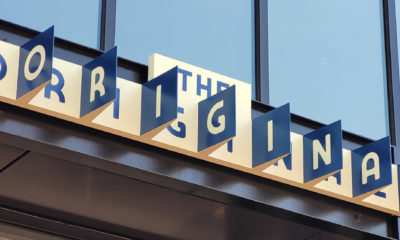An operative from a federal agency called me to ask if I could produce a handcarved, gilded sign similar to those I fabricated for the government’s General Services Administration (GSA) a few years ago. In that project, we were asked to produce signage that would help return the lobby of a 65-year-old, federal courthouse to its yesteryear elegance. This beautiful, Depression-era lobby, rich in handcrafted features, had fallen victim to plastic and vinyl.
I assumed the agent was calling for additional courthouse or GSA facility signage — not so. The proposed sign was destined for an undisclosed location, but in the style of the aforementioned courthouse. Thereafter, I communicated with the agent strictly via email and phone regarding design selection, prices and the purchase contract. We never met the agent until the installation day (more on that later).
Coating and masking
Before beginning production, I considered the substrate. Because it was for interior use, we chose mahogany’s rich beauty, which we accented with a clearcoat finish. For exterior installations, wood requires a sign-compatible paint; clearcoats won’t survive the elements.
Advertisement
I applied red mahogany stain to the 35 x 45-in. panel with cheesecloth and let it dry overnight. Although I could’ve used any stain, this particular product amplifies mahogany’s beautiful texture and grain. Usually one coat of stain suffices; more will produce a deeper color. Once the stain dried, I could apply clearcoat. I applied three to five coats of high-gloss, oil-based spar vanish and allowed overnight drying after each coat. Between coats, I lightly sanded with 320-grit sandpaper.
After the clearcoating, I applied a removable vinyl mask to the entire panel. I produced the design using Adobe Illustrator®, which allowed us to print out “tile” segments of the full design on 8½ x 11-in., vellum paper. We then sprayed the reverse-side of these printed “tiles” with an adhesive. The “tiles” were assembled on the vinyl-clad panel using registration lines that ensure level surfaces.
The carve
I began handcarving with a v-parting tool to cut “root lines” for each letter. Next, I shaped each letter with a No. 2, sweep-gouge chisel, which I followed with a No.1, straight chisel that refines gouge cuts. For a complete guide to handcarving techniques, read my feature, “The Importance of Being Shallow” (see ST, October 2006, page 90). After having carved the letters, I coated the bare wood surfaces with varnish. I could’ve used the same spar varnish I used on the panel surface, but, to save time, I used a faster-drying, waterbased varnish. Once this varnish dried, I removed the overlapping varnish around each letter by sanding them with 120-grit paper.
Advertisement
To prepare the carved letters for sizing, I dusted them with kaolin powder. I spread it out smoothly and vacuumed off any excess. Normally, at this stage of exterior-sign fabrication, I would’ve painted the lettering black, and the kaolin film would make the black paint appear grey. I dust varnished letters with kaolin in lieu of adding a “tint,” such as yellow paint or another colored foreign material. The size remains pure and uncontaminated, yet quite discernible, when applied.
Part Two
Francis S. Lestingi, a former physics professor, owns Williamsville, NY-based Signs of Gold.


 Photo Gallery1 week ago
Photo Gallery1 week ago
 Ask Signs of the Times2 weeks ago
Ask Signs of the Times2 weeks ago
 Paula Fargo1 week ago
Paula Fargo1 week ago
 Real Deal5 days ago
Real Deal5 days ago
 Photo Gallery1 week ago
Photo Gallery1 week ago
 Women in Signs2 weeks ago
Women in Signs2 weeks ago
 Women in Signs2 weeks ago
Women in Signs2 weeks ago
 Projects5 days ago
Projects5 days ago























